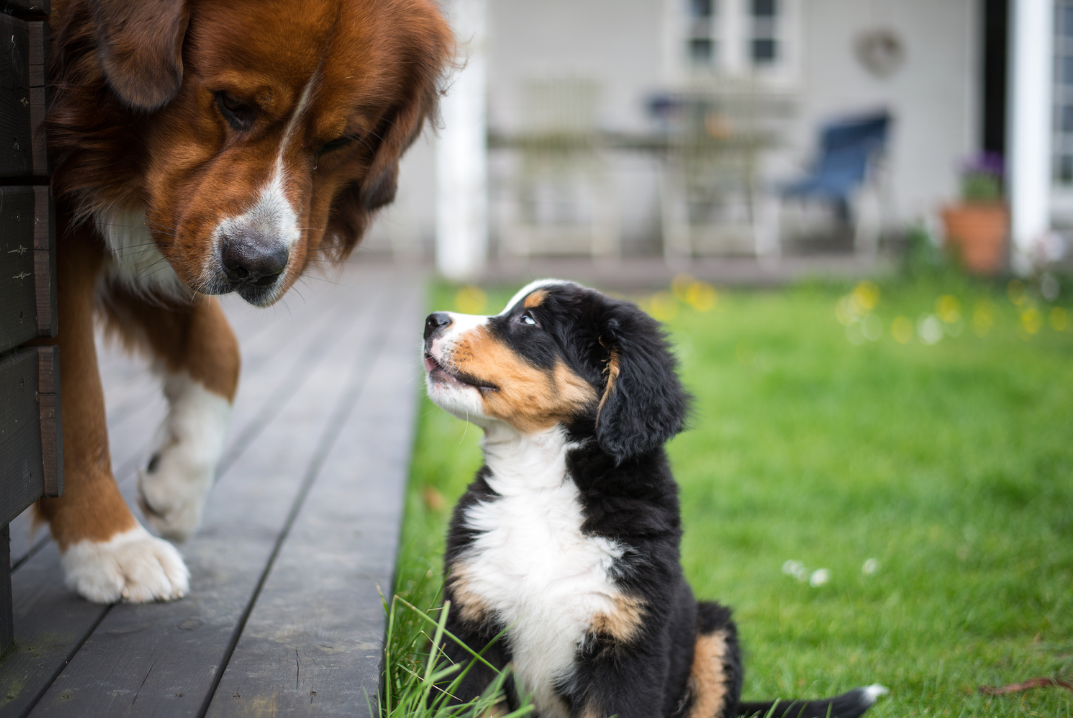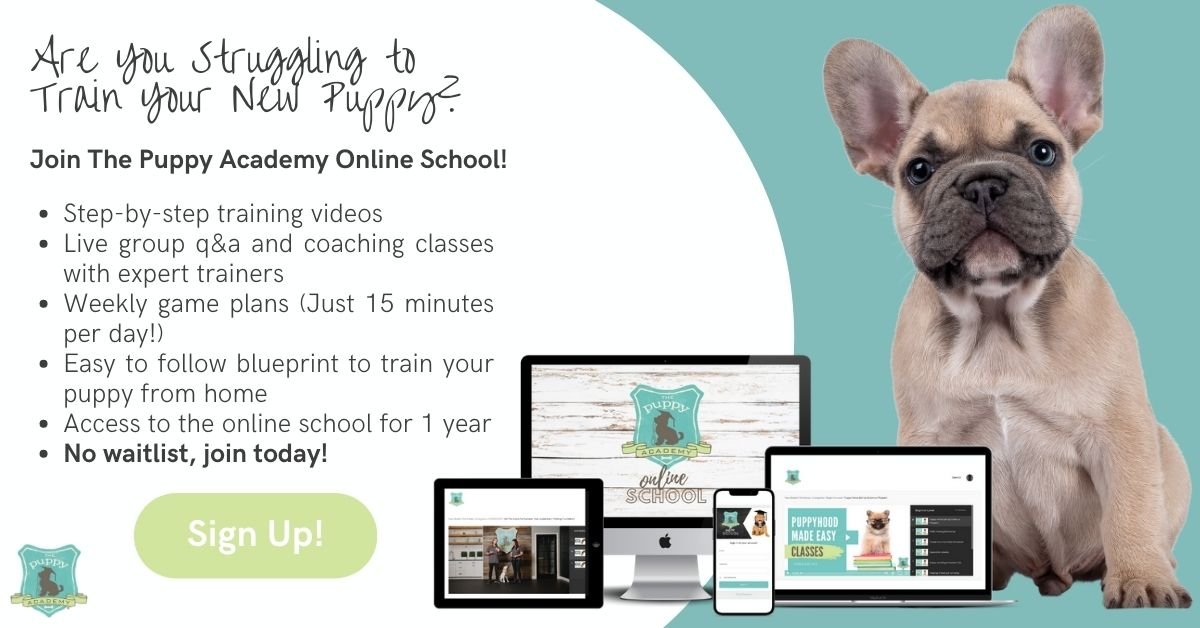Puppy introductions, especially if you already have an older family dog, can be a little nerve-wracking. What if they don’t like each other? Well, we’ve got useful and successful tips to help you introduce your puppy to your dog and help them establish a new friendship!
Bringing home a new puppy is a wonderful occasion for the entire family, including your current family dog! Introducing them to each other is a crucial step for your pups to form a lasting bond and learn to co-habitat as family members.
With the tips outlined in this blog, we’ll walk you through pre-planning for your pups' introduction and our expert trainers’ guidance to make the meeting process as smooth and enjoyable as possible! So if you’ve decided that today is the day for the big introduction, read up on our tips below!
BRINGING HOME A NEW PUPPY SOON? ONLINE PUPPY TRAINING OFFERS FLEXIBLE LIVE & ON-DEMAND CLASSES!
How to Set the Stage for Your Pups to Meet!
1. Vaccinations
Before introducing your new puppy to your family dog, make sure that both of your pups are up-to-date on their vaccinations! Certain illnesses are easily transferable from an older dog to a young puppy even if your older pup has had their vaccines in the past. This includes assuring both pups are clear of parasites like Giardia, Coccidia, as well as worms!
2. Go to a Neutral Location
Next, our recommendation to our students’ parents is to bring their pups to a neutral location. Pick a place like around the corner from your house or at a nearby park for their first interaction. This will also mitigate any territorial behaviors and just allow your older puppy to engage with your new puppy without feeling like their space is being encroached.
3. Remove Your Current Pups’ Things
After their initial meetup outdoors, it’s time to move the introductions inside. In this scenario, you’ll want to create a neutral environment at home! It’s simple to do: remove your current pups’ toys, bowls, bed, and other items they may become possessive over in the presence of your new puppy. In general, taking the time to create a comfortable and controlled space is a great tip, especially if you have any concerns about territorial behaviors bubbling up during your pups’ introduction.
4. No Sharing, Yet
Continue the neutrality of their initial few meetings for a few days, or even longer. You want to make each of their ongoing interactions go as smoothly and agreeable as possible! To do this, give your new puppy their own things: bed, toys, bowls, etc., as well as their own crate or playpen area with enough space for them to go to relax and want some time on their own. By keeping their items separate you are avoiding any potential for possessive behaviors, but also giving your puppy specific boundaries of things they can engage with and can’t.
How to Introduce Your New Puppy to the Family Dog!
There are a few different techniques you can use to ease your pups into their first meeting.
1. Let your older pup get acquainted first by giving them something that belongs to your new puppy like a blanket or toy from their breeder or shelter. Let your current pup sniff and get used to being in the presence of that new scent ahead of time, maybe even a few days before setting a face-to-face introduction.
2. For a controlled introduction, using a barrier such as a gate or playpen allows your pups to safely meet, sniff, and be around each other without physically interacting just yet. And you can use these tools each time they meet until they get their curiosity out of their system and are used to seeing each other. When the barrier finally comes down, keep a leash attached to each one of your pups, so you can easily guide them away from each other when needed.
3. Use training routines to your advantage as a way to help reduce any nerves and tension! Keeping them engaged in performing tasks versus just letting them loose in the yard and watching what happens, can help you maintain a calm and controlled experience. A new puppy might not know any commands just yet but your older pup can help show them how it’s done. Ask for a Sit, Stay, and Come, while letting your new puppy watch or play nearby.
4. Extra love is not necessary! Your instinct may be to dote on your older pup so they don’t feel left out. Instead, just keep things to their regularly scheduled routine. This is far more effective at helping your pup understand nothing has changed with the addition of a new puppy and helps them feel more comfortable.
5. Start working on establishing boundaries with your puppy from the very first day. You can read our blog on teaching your puppy good manners, to deter them from jumping, mouthing, generally getting away with things. Also, let your current pup continue to see you giving structure to your new pup by implementing a daily puppy schedule. This helps to maintain the established structure at home.
6. Only let your pups engage together during specific times. Set controlled playtime instead of letting them be with each other all the time which can lead to over-stimulation or encourage your pups to develop what is called “pack mentality” (your pups will only want to interact with each other and start feeding off each other's behaviors). In that situation, you might even notice your older pup starts to not listen as they did before. Once your pups have interacted, give them time to decompress and settle separately in their designated crate or just in a separate space in the room.
Pro tip: Two pups, two people! On the day of their introduction, enlist the help of a family member or close friend to help oversee the pups, handle their leash, and assist in activities like puppy training.
Things to Look Out For During their Meeting
Of course, there are some watch-outs to look out for when introducing your puppy to the family dog. Puppies are still getting a handle on their surroundings and their energy. Older pups have learned the ropes of being part of the family, have their own established routines and might have mellowed out of the high puppy energy. Keep these points in mind when your pups are meeting for the first time so you know when your pups might need a little break.
Is Your Puppy Getting Overly Excited?
Puppy energy can be a lot to manage, even for an adult dog! Watch your puppy to ensure they aren’t jumping all over, chewing on, nipping, barking at, and just becoming too much for your other pup. And vice versa! You might have an older pup that is playing too rough for a younger puppy. If you notice these behaviors in either one of them, it's a good opportunity to interrupt the play and to give them a little space to settle down on their own. This is a good time to give them separate time or even work on a calming routine with your pups.
Watch for Body Language Cues
Notice if either of your pups start to back away in a corner or under a chair if the hackles (the fur running down their spine) start to raise, teeth-baring or growling start to occur. These body language signs are responses to either over-stimulation or tension which are good indicators that it’s time for another break from their activity together. Never force them to play or interact together. Give each pup space and time they need to get comfortable with each other and always advocate for the pup who's showing behaviors that are more submissive. Meaning, don't let one pup get "picked on" by the other. Step in for them if one is being too jumpy, too nippy, or too energetic for them, and you can tell the other is getting agitated or wants to run away.
Supervision is Key
Always supervise your pups when they are put together and don’t let them “work it out” on their own. Young puppies often don’t understand the boundaries your older pup is trying to tell them just yet so will need you to step in. Keep their size in mind too! Larger breeds grow quickly and often aren’t aware of their size or strength and can unintentionally hurt a smaller pup during play.
Need Help with Socialization?
Our Online Puppy School has a curriculum full of common puppyhood pains that almost every new puppy owner faces — including how to introduce your puppy to new dogs, people, and situations they will encounter throughout their life!
You’ll be able to watch as our master trainers walk you through real-time puppy socialization demos to better understand a puppy’s body language and signs to look out for when they’re playing, including when you should step in to interrupt playtime as behaviors are escalating and how to do it!
Plus you’ll be able to interact with our trainers every week to ask them (or even show them!) any socialization issues you’re having so they can help coach you through it.
Learn more about The Puppy Academy Online School and how it can help you make puppyhood easy starting today!
Learn more about The Puppy Academy Online School!
If you have a puppy training question, join us weekly on @thepuppyacademy Instagram at 1 p.m. PT for our live Ask a Puppy Trainer show! Get your questions answered by expert puppy trainers! And don’t forget to sign up for our Very Important Puppy mailing list to receive updates, puppy training tips, and more!
Check out these blogs related to puppy training and more!
Create a Daily Puppy Schedule!




